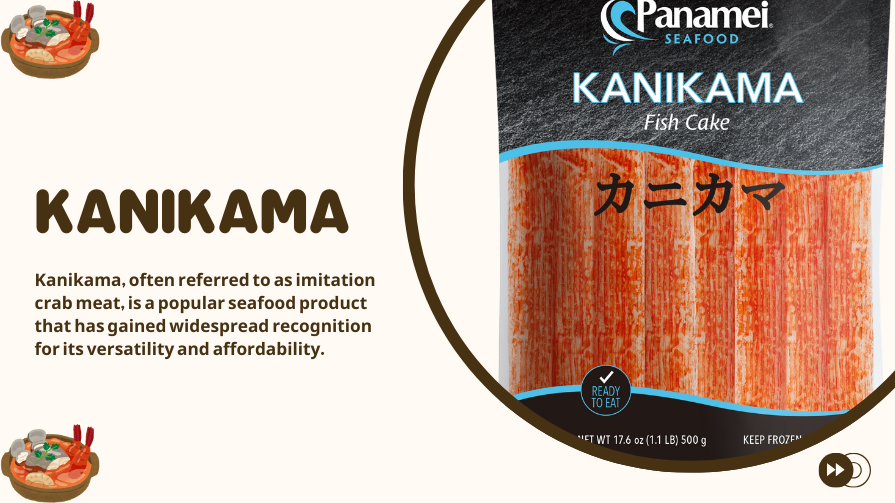Kanikama, often referred to as imitation crab meat, is a popular seafood product that has gained widespread recognition for its versatility and affordability. Originating from Japan, kanikama is made primarily from white fish, usually pollock, which is processed and flavored to resemble crab meat. This guide delves into the intricate details of kanikama, exploring its history, production process, culinary uses, and nutritional benefits.
The History of Kanikama
The journey of kanikama began in Japan in the early 1970s. Initially developed as a cost-effective alternative to real crab meat, kanikama quickly became a staple in Japanese cuisine. The innovative technique of transforming white fish into a crab-like delicacy was pioneered by food technologists who sought to create a product that was not only economical but also delicious and versatile.
How Kanikama is Made
Selection of Raw Materials
The foundation of high-quality kanikama lies in the selection of the finest white fish. Pollock is the preferred choice due to its mild flavor and firm texture. The fish is meticulously cleaned and deboned to ensure the purity of the final product.
Surimi Production
Surimi, a Japanese term meaning “ground meat,” is the key ingredient in kanikama. The fish fillets are finely minced and washed repeatedly to remove any impurities and unwanted fats. This process results in a smooth, protein-rich paste known as surimi. The surimi is then mixed with various binding agents, such as starch and egg whites, to enhance its texture and stability.
Flavoring and Coloring
To mimic the taste and appearance of real crab meat, surimi is flavored with natural and artificial crab extracts. Additionally, red food coloring is added to the outer layer to create the characteristic orange hue of crab legs. This step is crucial in making kanikama visually appealing and authentic in taste.
Shaping and Cooking
The flavored and colored surimi is then molded into the desired shape, typically resembling crab legs or flakes. The shaped surimi is cooked through steaming or baking, which helps set the texture and flavor. Once cooked, the kanikama is cooled and packaged, ready for distribution.
Culinary Uses of Kanikama
Kanikama’s versatility makes it a beloved ingredient in various culinary traditions. Here are some popular ways to incorporate kanikama into your meals:
Sushi and Sashimi
Kanikama is a staple in many sushi rolls, such as California rolls and spicy crab rolls. Its mild flavor pairs well with other ingredients like avocado, cucumber, and mayonnaise, creating a delightful combination of textures and tastes.
Salads
Kanikama can be shredded or diced and added to salads for a protein boost. It works particularly well in seafood salads, combining harmoniously with ingredients like lettuce, tomatoes, and a light vinaigrette.
Soups and Stews
Kanikama adds a rich, umami flavor to soups and stews. It can be used in miso soup, chowders, and hot pots, enhancing the overall depth of the dish.
Appetizers and Snacks
For a quick and easy appetizer, kanikama can be served with dipping sauces or incorporated into spring rolls and dumplings. Its firm texture and savory taste make it an excellent choice for finger foods.
Nutritional Benefits of Kanikama
Kanikama is not only delicious but also nutritious. Here are some of its key nutritional benefits:
Low in Calories
One of the significant advantages of kanikama is its low calorie content. A typical serving of kanikama contains fewer calories than an equivalent serving of real crab meat, making it an excellent option for those watching their calorie intake.
High in Protein
Kanikama is a good source of protein, which is essential for muscle repair and growth. The surimi base provides a protein-rich alternative to traditional seafood.
Low in Fat and Cholesterol
Unlike real crab meat, kanikama is low in fat and cholesterol. This makes it a heart-healthy choice, suitable for individuals looking to reduce their intake of saturated fats.
Rich in Vitamins and Minerals
Kanikama is fortified with various vitamins and minerals during the production process. It is a good source of vitamin B12, which is vital for nerve function and the production of red blood cells. Additionally, it contains essential minerals like phosphorus and selenium.
Sustainability and Environmental Impact
Kanikama production has a relatively lower environmental impact compared to traditional crab fishing. The use of abundant fish species like pollock helps in conserving crab populations and maintaining ecological balance. Moreover, the efficient production process of surimi ensures minimal waste, contributing to sustainable seafood practices.
Choosing and Storing Kanikama
When purchasing kanikama, it is crucial to select high-quality products to ensure the best taste and texture. Here are some tips for choosing and storing kanikama:
Check the Ingredients
Read the ingredient list to ensure that the kanikama is made from high-quality surimi and does not contain excessive additives or preservatives. Opt for brands that use natural flavorings and colors.
Storage Tips
Kanikama should be stored in the refrigerator and consumed within a few days of opening. If you purchase frozen kanikama, follow the thawing instructions on the packaging to maintain its texture and flavor. Avoid refreezing thawed kanikama, as this can affect its quality.
Conclusion
Kanikama, or imitation crab meat, is a versatile and nutritious seafood product that offers numerous culinary possibilities. Its rich history, sustainable production process, and delightful taste make it a valuable addition to any kitchen. Whether you’re making sushi, salads, or soups, kanikama provides a delicious and affordable alternative to real crab meat.

